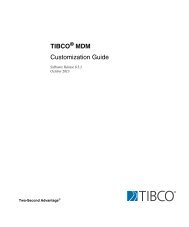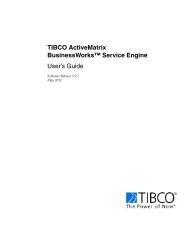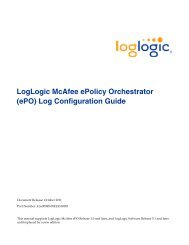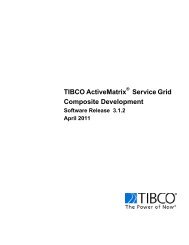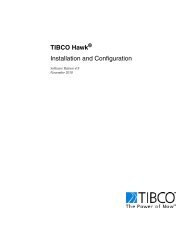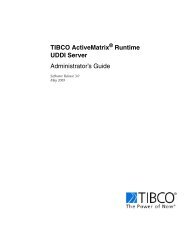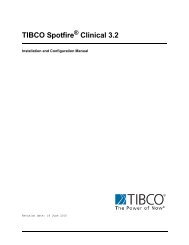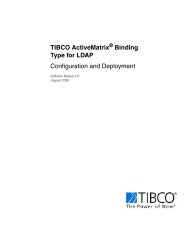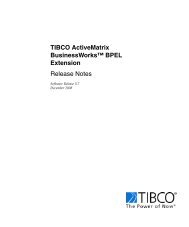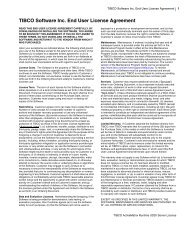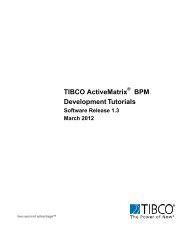TIBCO Spotfire Server 3.2.2 - TIBCO Product Documentation
TIBCO Spotfire Server 3.2.2 - TIBCO Product Documentation
TIBCO Spotfire Server 3.2.2 - TIBCO Product Documentation
Create successful ePaper yourself
Turn your PDF publications into a flip-book with our unique Google optimized e-Paper software.
Installation Planning<br />
If you are running <strong>Spotfire</strong> <strong>Server</strong> 3.0 or 3.1, you can perform an upgrade to <strong>Spotfire</strong><br />
<strong>Server</strong> 3.2. This entails running the Upgrade Tool, distributed with the <strong>Spotfire</strong> <strong>Server</strong>.<br />
This tool will modify the 3.0 or 3.1 database so that the 3.2 server can read and write<br />
from and to it, and also copy configuration from a 3.0 or 3.1 server installation.<br />
Additionally, the Upgrade Tool can also read information from an already installed 3.2<br />
server. Because the Upgrade Tool modifies an existing database, it is important that<br />
you back up the 3.0 or 3.1 database, or make a copy of it and perform the upgrade on<br />
this copy.<br />
1.4 Conceptual Outline of Installation<br />
Process<br />
Each step outlined below is explained in detail in “Installing <strong>Spotfire</strong> <strong>Server</strong> 3.2” on<br />
page 16. You should read through that chapter as well as this outline before you<br />
attempt an installation.<br />
1 Read the “Pre-Installation Checklist” on page 10 and write down the needed<br />
information.<br />
2 Prepare the <strong>Spotfire</strong> database. If you are upgrading from 3.0 or 3.1 this includes<br />
backing up or cloning the existing database. If you are performing a fresh install or<br />
migrating from 10.1, this includes creating new database tables.<br />
3 Run the <strong>Spotfire</strong> <strong>Server</strong> installer on all intended machines.<br />
4 Install the latest patch, if any, released for <strong>Spotfire</strong> <strong>Server</strong> since its release.<br />
5 If needed, replace DataDirect database drivers shipped with <strong>Spotfire</strong> with native<br />
database drivers from your database vendor.<br />
6 If you are performing a migration from 10.1, run the migration tool. If you are<br />
performing an upgrade from 3.0 or 3.1, run the upgrade tool.<br />
7 Log into the configuration console.<br />
8 If you have upgraded from 3.0 or 3.1, verify that the configuration is intact. If you<br />
have performed a new install or a migration from 10.1, configure the system regarding<br />
authentication, user directory, etc.<br />
9 Add servers to cluster or verify that all upgraded servers are in the cluster.<br />
10 If load balancing is to be used, set up a load balancer and configure it to communicate<br />
with the <strong>Spotfire</strong> <strong>Server</strong>s.<br />
11 Assign the first <strong>Spotfire</strong> Admin. You will need the unlock code located in the file<br />
codes.txt distributed with the <strong>Spotfire</strong> <strong>Server</strong>.<br />
The <strong>Spotfire</strong> <strong>Server</strong> is now up and running. Next, a number of administrative tasks<br />
need to be performed before the users can use the <strong>Spotfire</strong> system. These tasks are<br />
described in the <strong>TIBCO</strong> <strong>Spotfire</strong> - Deployment and Administration Manual<br />
distributed with the <strong>TIBCO</strong> <strong>Spotfire</strong> Deployment.<br />
<strong>TIBCO</strong> <strong>Spotfire</strong>® <strong>Server</strong> <strong>3.2.2</strong> 9 (144)



